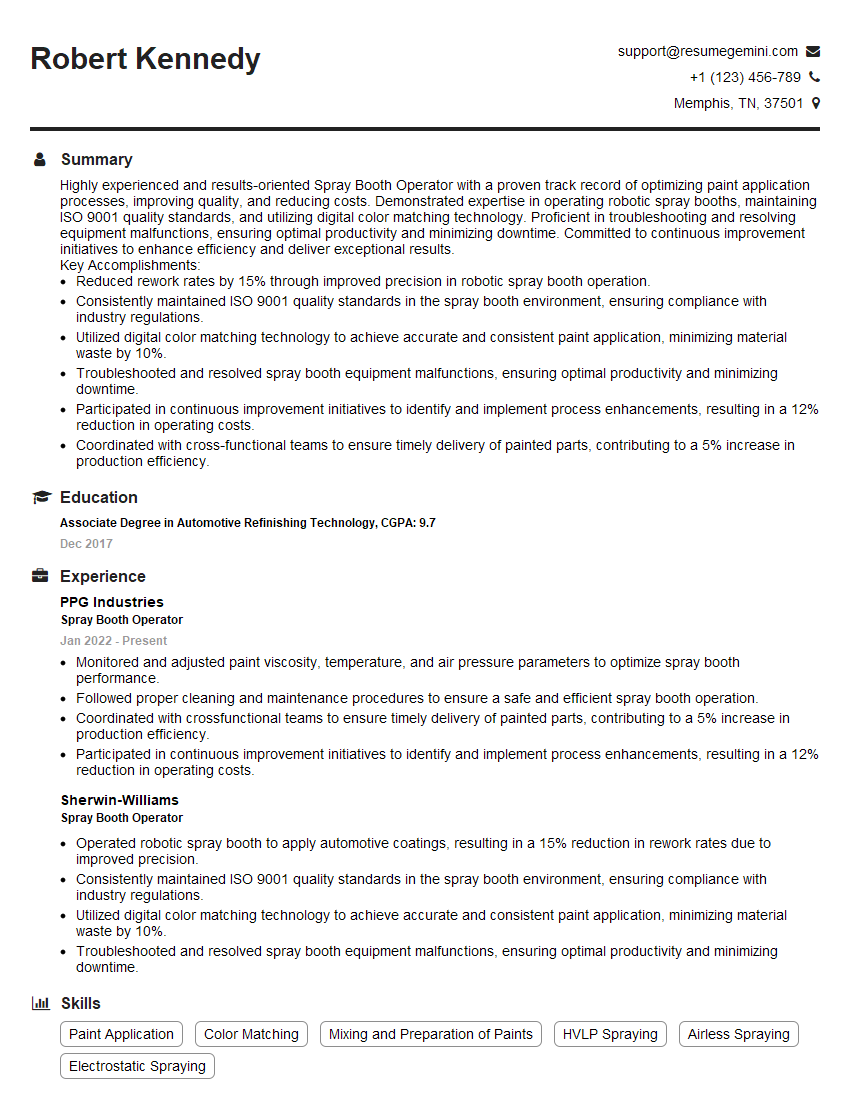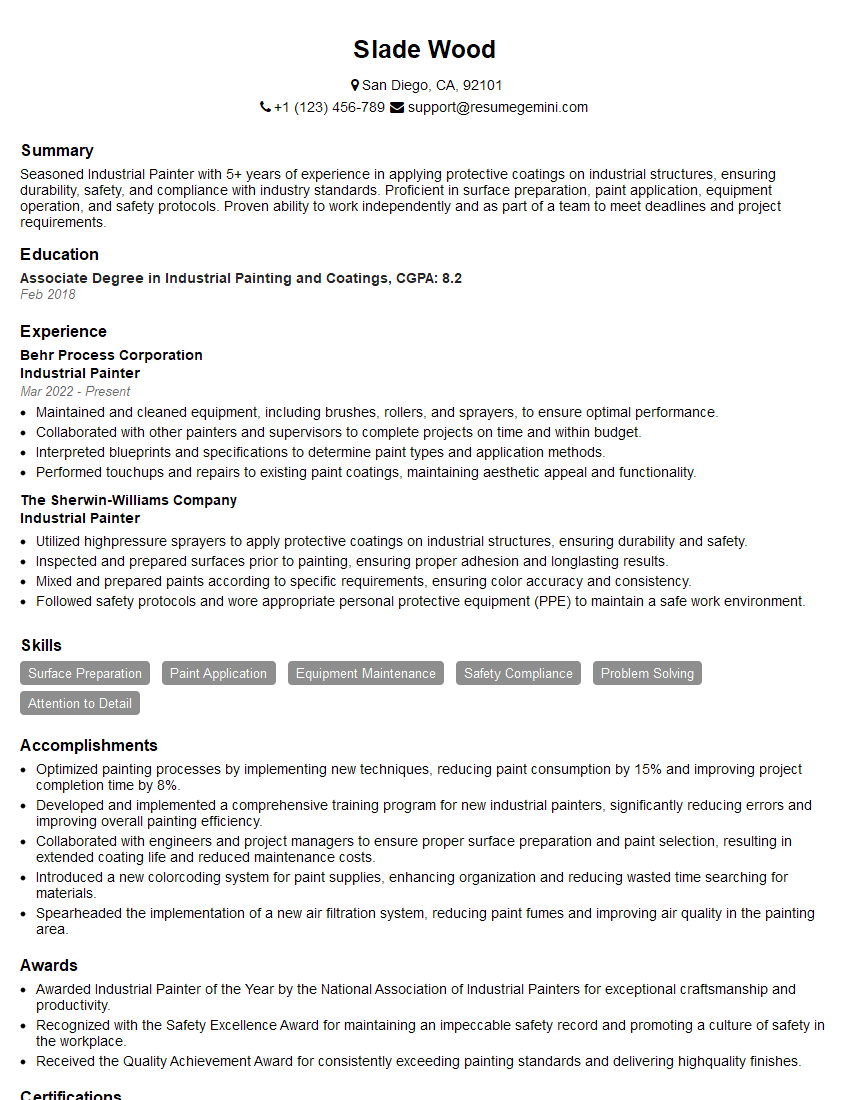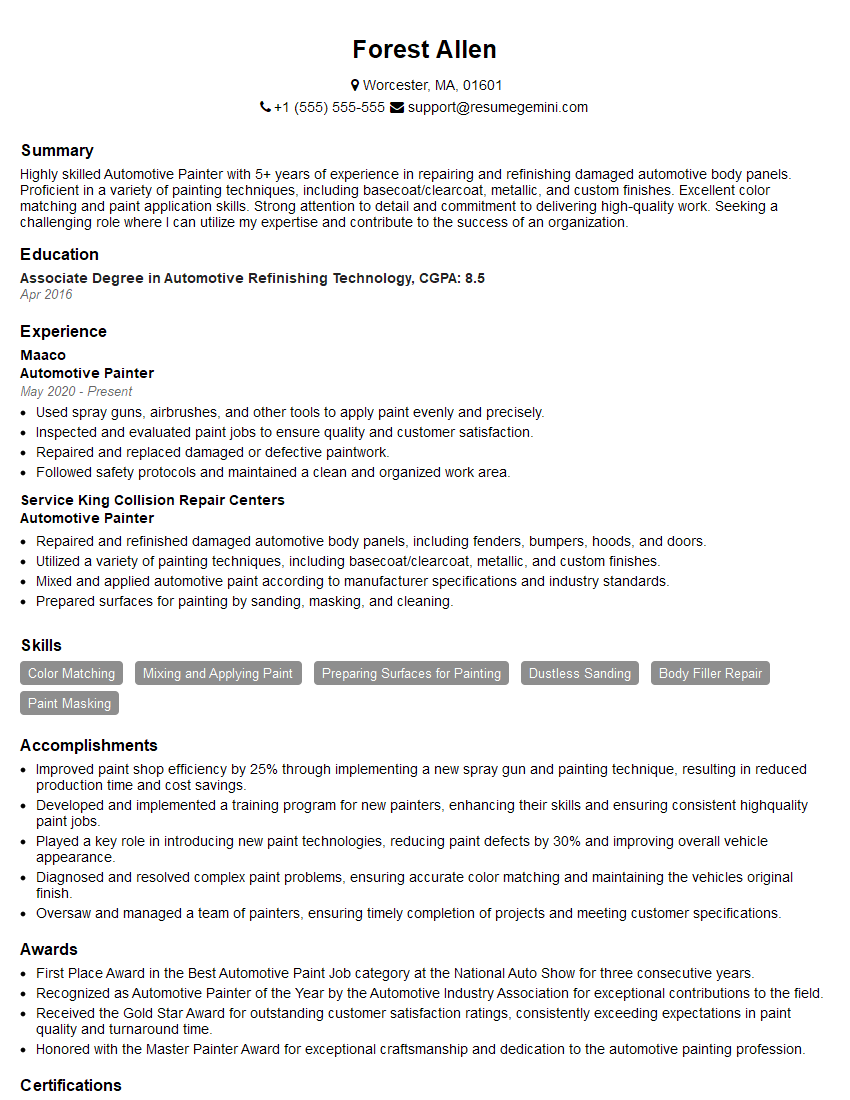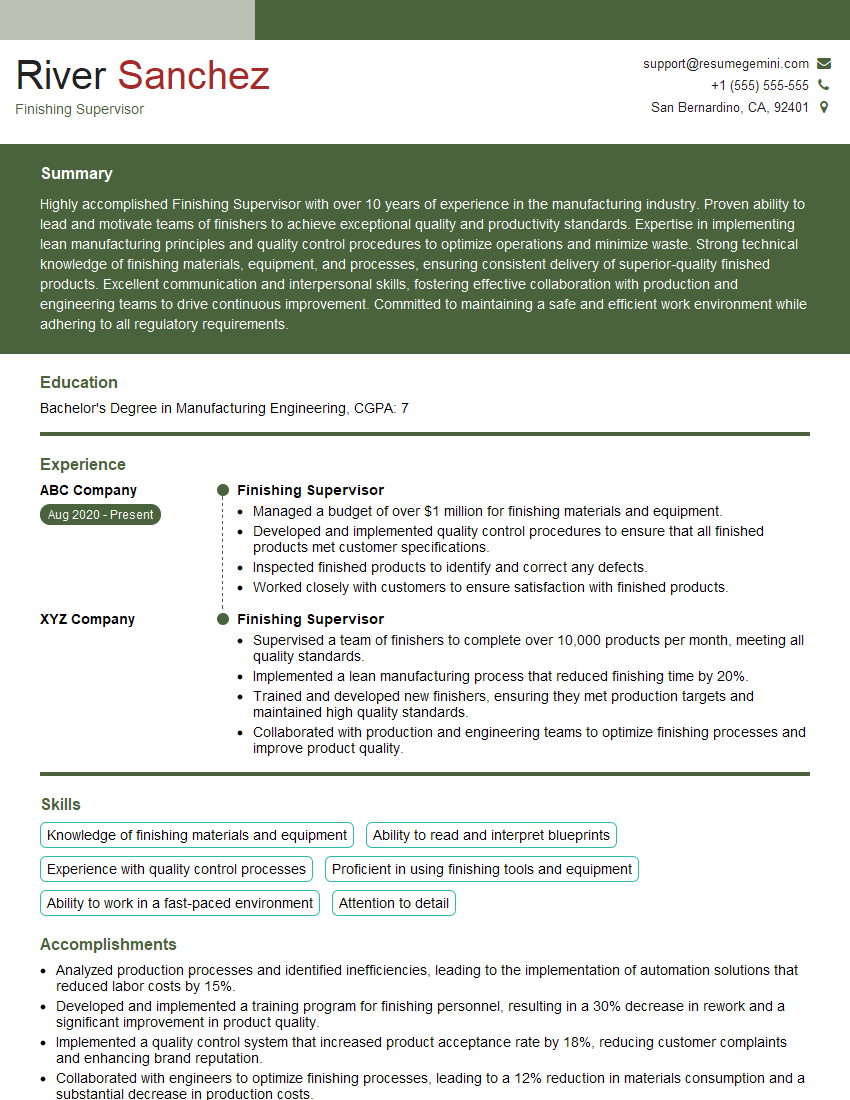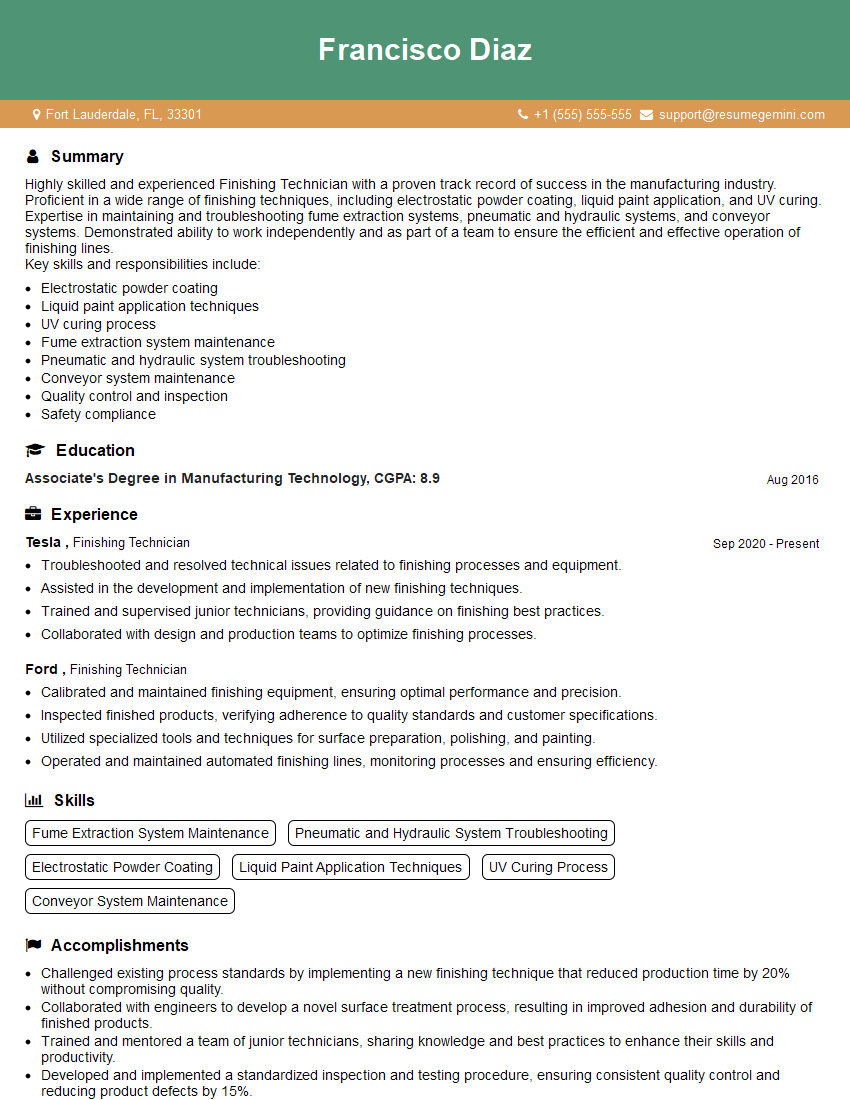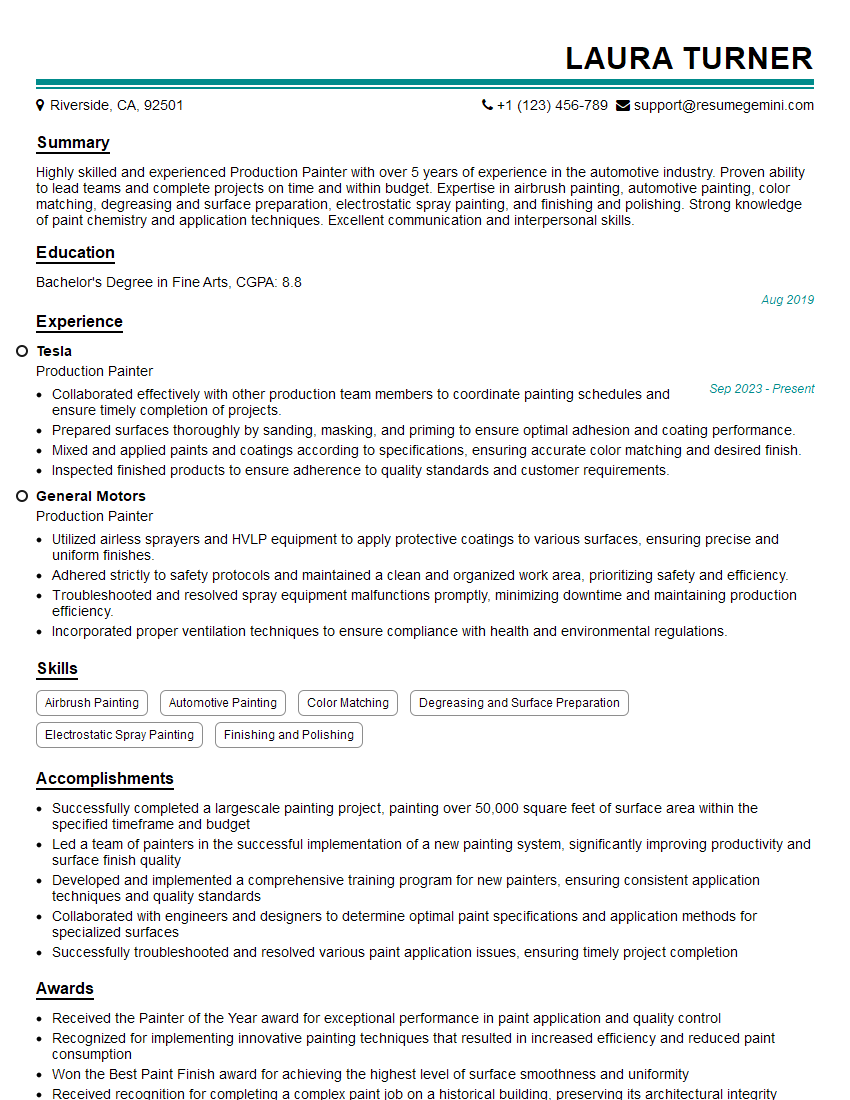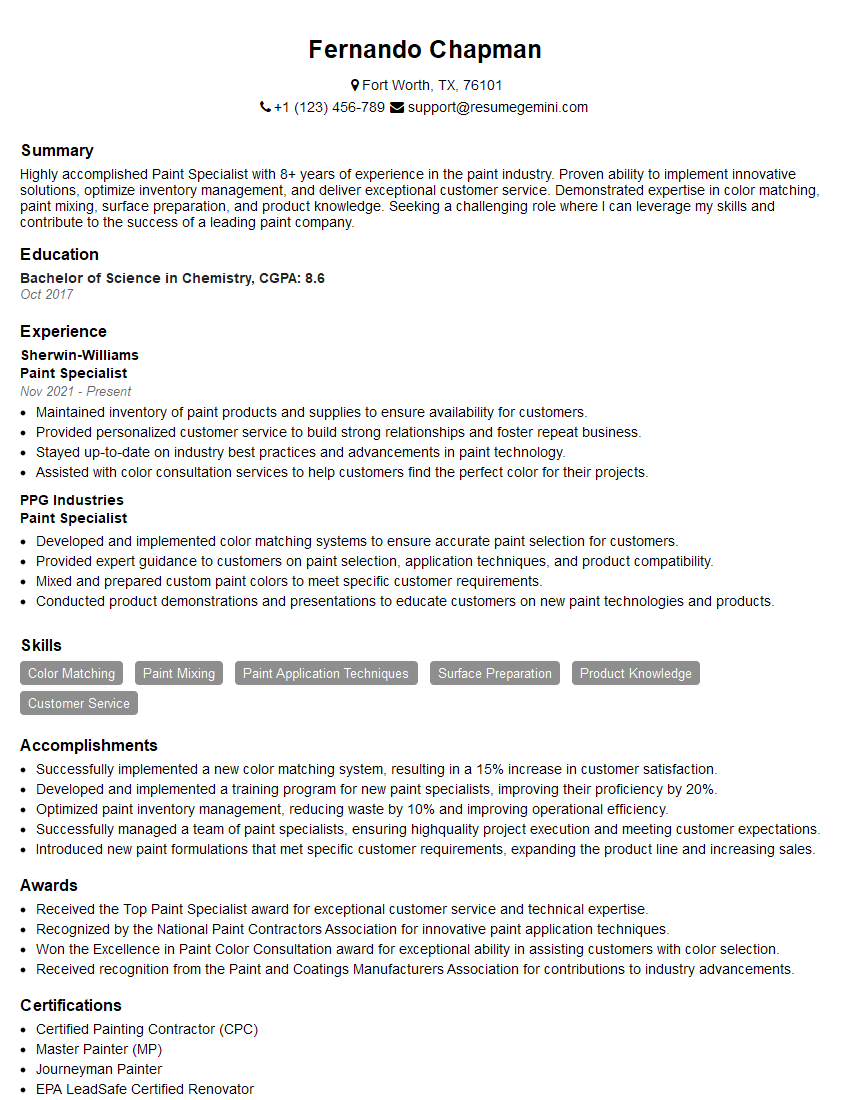The thought of an interview can be nerve-wracking, but the right preparation can make all the difference. Explore this comprehensive guide to Airless Spraying interview questions and gain the confidence you need to showcase your abilities and secure the role.
Questions Asked in Airless Spraying Interview
Q 1. Explain the difference between airless and conventional spray painting.
Airless and conventional spray painting differ fundamentally in how they atomize the paint. Conventional spray painting uses compressed air to atomize the paint, creating a fine mist. This method is often less efficient, produces more overspray, and requires more precise control. Think of it like using a water pistol – you need careful aim to avoid waste.
Airless spraying, on the other hand, uses high pressure to force the paint through a small nozzle, creating a much finer atomization. It’s like using a power washer – the pressure does most of the work, leading to less overspray and faster application. This makes it more efficient, especially for large projects. The difference is analogous to a gentle rain shower (conventional) versus a forceful jet of water (airless).
Q 2. Describe the various types of airless spray guns and their applications.
Airless spray guns come in various types, each designed for specific applications:
- Standard Airless Spray Guns: These are versatile and suitable for a wide range of projects, from painting walls to fences. They offer a good balance between efficiency and control.
- HVLP (High Volume Low Pressure) Spray Guns: While technically not ‘airless,’ they’re often compared. They use less air pressure than conventional spray guns, resulting in less overspray and better paint transfer efficiency. They are best for finer finishes, but are slower than true airless systems.
- Airless Spray Guns with RAC (Reverse Airless Cup): These guns use a separate cup system that holds the paint, making them ideal for smaller projects or touch-ups where carrying large containers isn’t feasible.
- Airless Spray Guns with Electric Motors: These offer portability and are great for smaller jobs. They’re becoming increasingly popular as battery technology improves.
The choice depends on the project scale, desired finish quality, and budget. A large exterior painting project would benefit from a powerful, high-capacity standard airless gun, whereas a small furniture project might be better suited to an HVLP or smaller airless unit with an RAC.
Q 3. What are the safety precautions when using airless spray equipment?
Safety is paramount when using airless spray equipment. Here are key precautions:
- Eye Protection: Always wear safety glasses or a full face shield to protect against paint splashes and overspray.
- Respiratory Protection: Use a respirator approved for paint overspray to prevent inhalation of paint particles. This is crucial, as many paints contain harmful chemicals.
- Protective Clothing: Wear long sleeves, long pants, and closed-toe shoes to protect your skin from paint contact.
- Proper Ventilation: Work in a well-ventilated area or use appropriate ventilation equipment to prevent buildup of paint fumes.
- Fire Safety: Be aware of fire hazards associated with solvents and paints. Keep a fire extinguisher nearby and avoid working near open flames.
- High-Pressure Risk: Never point the spray gun at yourself or others. Be mindful of the high pressure involved and follow manufacturer’s safety guidelines carefully.
Remember, safety is not optional; it’s essential for your health and well-being.
Q 4. How do you determine the correct spray tip size for a given project?
Selecting the correct spray tip size is crucial for achieving the desired finish and preventing clogging. The size is determined by several factors:
- Viscosity of the paint: Thicker paints require larger tips to allow for smooth flow; thinner paints require smaller tips to prevent overspray.
- Type of material being sprayed: Different materials have different texture and density, requiring adjustments to the tip size.
- Desired finish: A finer finish usually requires a smaller tip size for better atomization, while a coarser finish, like for exterior siding, allows for a larger tip.
Manufacturers provide charts that correlate tip size to paint viscosity and material type. Always consult this chart for your specific paint and application. Experimenting with different tip sizes on scrap material is highly recommended before starting your project.
For example, a thicker latex exterior paint might use a 0.017” to 0.021” tip, while a thinner primer might use a smaller 0.011” to 0.015” tip.
Q 5. Explain the concept of fluid tip and its importance in airless spraying.
The fluid tip is the nozzle at the end of the spray gun through which the paint is atomized. It’s a critical component, influencing the spray pattern, material flow, and final finish. The size and design of the fluid tip directly impact the quality of the spray.
Its importance lies in its ability to regulate the paint flow and atomization. A properly sized and maintained fluid tip ensures consistent paint application, optimal atomization, and a smooth, even finish. Using the wrong tip size can lead to uneven coverage, excessive overspray, clogging, and poor quality.
Think of it like a kitchen faucet; the aerator (analogous to the fluid tip) controls the water flow and stream. A worn or incorrectly sized aerator would result in a poor water stream, similar to a worn or wrongly chosen fluid tip.
Q 6. How do you troubleshoot common airless spray equipment problems, such as clogging or low pressure?
Troubleshooting common airless spray equipment problems involves a systematic approach:
- Clogging: This is usually caused by thick paint, impurities in the paint, or a worn-out fluid tip. First, check the fluid tip for any blockages. Clean or replace as necessary. Then, strain the paint through a fine-mesh filter to remove any impurities. If the problem persists, try thinning the paint according to manufacturer’s instructions.
- Low Pressure: This often indicates a problem with the pump or air supply. Check the pump for leaks or damage. Ensure the power supply is adequate and the pressure regulator is set correctly. Also, check the intake filter for blockages.
- Uneven Spray Pattern: This might be caused by a worn fluid tip, improper spray gun technique, or a partially clogged filter. Inspect the fluid tip and replace if damaged. Ensure the spray gun is held at the correct distance and angle. Check the filter for blockages.
Always consult your equipment’s manual for specific troubleshooting guidance. If the problem persists after these steps, professional service may be necessary.
Q 7. Describe the different types of paints suitable for airless spraying.
Many types of paints are suitable for airless spraying, but some are better suited than others:
- Latex Paints (Water-Based): These are very common and work well with airless sprayers. They are relatively easy to clean up and have low VOC (Volatile Organic Compound) emissions.
- Acrylic Paints: Similar to latex paints, these are widely used and compatible with airless spraying. They offer good durability and adhesion.
- Oil-Based Paints: These are more durable than water-based paints but require solvents for cleanup and have higher VOC emissions. They can be sprayed with airless equipment but require careful consideration of ventilation and safety precautions.
- Epoxies and Urethanes: These specialized coatings are often used for industrial applications and require specialized airless spray equipment and techniques due to their high viscosity and specific application requirements.
- Stains and Sealers: Many stains and sealers are also compatible with airless sprayers, offering efficient application for large surfaces.
Always check the paint manufacturer’s recommendations to ensure compatibility with airless spraying equipment and to achieve optimal results.
Q 8. What are the factors affecting spray pattern and how do you adjust them?
The spray pattern in airless spraying, essentially the shape and size of the paint distribution, is heavily influenced by several factors. Think of it like a garden hose: the nozzle’s shape and pressure directly impact the water’s spread. Similarly, in airless spraying, we have:
- Nozzle Tip Size and Type: Larger tips deliver more paint at higher pressure, resulting in a wider, heavier spray pattern. Different tip shapes (e.g., round, fan) produce distinct patterns. A fine finish might call for a smaller, round tip, while a fence might use a wide fan tip.
- Spray Tip Angle: The angle of the tip dictates the spray width. A 40-degree tip gives a narrower pattern than a 65-degree tip. Adjusting the angle changes the pattern’s horizontal reach.
- Spray Pressure: Higher pressure increases the paint’s velocity and widens the pattern, while lower pressure results in a narrower, less forceful spray. You might reduce pressure for intricate detailing or increase it for faster coverage on large surfaces.
- Distance from Surface: Maintaining a consistent distance is critical. Getting too close results in runs and drips, while too far leads to a patchy, uneven finish. The ideal distance usually depends on the tip size and paint viscosity, often found in the manufacturer’s instructions.
- Fluid Viscosity: Thicker paints will naturally produce a more concentrated spray pattern. Adding thinner can help adjust viscosity and the resultant spray pattern but must be done cautiously following manufacturer recommendations.
Adjusting these factors is a trial-and-error process, often requiring practice. Start with the manufacturer’s recommendations for your specific paint and nozzle. Fine-tune pressure and distance to achieve the desired coverage and finish. Remember safety – always wear appropriate personal protective equipment (PPE).
Q 9. How do you prepare a surface for airless spraying?
Surface preparation is paramount for a successful airless spray job. Imagine trying to paint a rusty, dirty wall – the paint won’t adhere properly. Preparation involves several key steps:
- Cleaning: Thoroughly clean the surface to remove dirt, dust, grease, mildew, and any loose paint. Pressure washing is often effective for exterior surfaces, while a brush and detergent may suffice for smaller areas. Always let surfaces fully dry before proceeding.
- Repairing: Fill any holes, cracks, or gaps with appropriate filler and allow adequate drying time before sanding smooth.
- Sanding: Smooth any rough patches using progressively finer sandpaper grades. This ensures a consistent surface for even paint adhesion.
- Priming: Applying a primer creates a uniform surface for the top coat, improving adhesion, hiding imperfections, and ensuring a more consistent color.
- Masking: Use painter’s tape and drop cloths to protect areas you don’t want to paint. This prevents overspray and makes cleanup easier.
Proper surface preparation might seem time-consuming, but it’s crucial. It directly impacts the paint’s durability, appearance, and longevity. Skipping this step often leads to repainting sooner than expected.
Q 10. Explain the importance of proper surface cleaning before painting.
Proper surface cleaning before painting is essential for several reasons. Think of it like building a house – you wouldn’t build on a weak, unstable foundation. Similarly, paint needs a solid base. If you don’t clean the surface, the paint won’t adhere properly. This leads to:
- Poor Adhesion: Dirt, grease, or mildew will prevent the paint from bonding correctly, resulting in peeling, chipping, and a shorter lifespan for your paint job.
- Uneven Finish: A dirty surface will create an uneven texture, leading to an inconsistent paint finish. The imperfections will show through, even after multiple coats.
- Reduced Durability: Poor adhesion means the paint is more susceptible to damage from the elements (sun, rain, etc.).
- Mold and Mildew Growth: If you don’t remove existing mold or mildew, it can continue to grow under the paint, leading to further problems.
In short, proper cleaning ensures a strong bond between the paint and the surface, resulting in a durable, long-lasting, and aesthetically pleasing finish.
Q 11. What are the different types of spray patterns and their uses?
Airless spray equipment offers different spray patterns, achieved through varying nozzle tips. Each pattern serves a specific purpose:
- Horizontal Fan Pattern: This is the most common pattern, ideal for covering large, flat surfaces like walls and fences. It provides efficient coverage and minimizes overlapping.
- Vertical Fan Pattern: Useful for painting trim, ceilings, and other vertical surfaces. The pattern’s orientation makes it easy to manage consistent coverage.
- Round Pattern: A narrow, circular pattern best suited for touch-ups, detailed work, or intricate areas. It provides precise control and minimizes overspray.
Choosing the right spray pattern directly impacts the efficiency and quality of your project. Using the wrong pattern can lead to wasted paint, uneven coverage, and a poor finish.
Q 12. How do you calculate the amount of paint needed for a project?
Calculating the paint needed accurately prevents shortages or excessive purchases. There’s no single formula, as it depends on the surface area and the paint’s coverage rate (specified by the manufacturer in square meters or feet per liter or gallon). Here’s a general approach:
- Measure the area: Calculate the total surface area to be painted. For simple shapes, use basic geometric formulas (length x width for rectangles, πr² for circles). For complex shapes, break them down into simpler ones and sum the areas.
- Check the coverage rate: Find the paint’s coverage rate on the product label. This typically indicates how many square meters or feet one liter or gallon will cover with one coat.
- Calculate paint per coat: Divide the total surface area by the paint’s coverage rate to determine the amount of paint needed per coat.
- Account for multiple coats: Most projects need multiple coats for optimal coverage and durability. Multiply the paint needed per coat by the number of coats.
- Add extra: Always add extra paint (typically 10-20%) to account for waste, touch-ups, and unexpected circumstances.
Example: You need to paint a wall (10m x 3m = 30m²) with a paint having 10m²/liter coverage. You need 3 liters per coat (30m²/10m²/liter). With 2 coats, you need 6 liters. Adding 20% extra, you need approximately 7.2 liters.
Q 13. Describe the process of cleaning and maintaining airless spray equipment.
Cleaning and maintaining your airless sprayer is crucial for longevity and preventing clogs. This involves several steps:
- Immediate Cleaning: After each use, immediately flush the system with the recommended thinner or cleaning solution. This prevents paint from drying and solidifying within the pump, hoses, and nozzle.
- Disassembly: Carefully disassemble the spray gun, removing the nozzle, filter, and other accessible parts. Clean each component thoroughly with a brush and thinner.
- Pump Cleaning: Follow the manufacturer’s instructions for cleaning the pump. This usually involves running a solvent through the system.
- Drying: Allow all parts to dry completely before storage. Store the equipment in a dry place to prevent corrosion.
- Regular Maintenance: Periodically inspect the equipment for wear and tear, replacing worn parts as needed. This includes checking seals, filters, and other critical components.
Regular cleaning not only extends the lifespan of your airless sprayer but also ensures consistent performance and prevents costly repairs.
Q 14. What are the environmental considerations when using airless spray equipment?
Airless spraying, while efficient, has environmental considerations. Overspray, the paint that misses the target surface, is a major concern. This leads to wasted paint, air pollution, and potential environmental contamination. Addressing this involves:
- Using appropriate PPE: Respirators and safety glasses protect the user from overspray inhalation and eye irritation.
- Proper setup and technique: Minimizing overspray depends heavily on proper surface preparation, consistent spray distance, and nozzle selection for the job. Training on efficient techniques is very helpful.
- Using low-VOC (Volatile Organic Compound) paints: VOCs contribute to air pollution and smog. Choosing low-VOC or water-based paints significantly reduces environmental impact.
- Proper disposal of waste: Dispose of paint waste according to local regulations. Never pour paint down drains or into the environment.
- Using containment measures: Employing drop cloths, masking, and other containment methods helps minimize overspray and waste.
By following environmentally conscious practices, we can minimize the negative impact of airless spraying and contribute to a cleaner and healthier environment.
Q 15. Explain the concept of overspray and how to minimize it.
Overspray is the paint that misses the intended target surface and lands on surrounding areas. Think of it like trying to water your garden with a hose – some water inevitably splashes onto the sidewalk. Minimizing overspray is crucial for efficiency, cost savings, and environmental responsibility. It reduces material waste and cleanup time.
- Proper Spray Technique: Maintaining a consistent distance from the surface (usually 12-18 inches, depending on the nozzle and material) and a smooth, even motion are paramount. Imagine you’re painting with a steady hand, not flinging paint.
- Correct Nozzle Selection: Choosing the right nozzle tip size for the material and project is essential. A tip that’s too large will result in excessive overspray; one that’s too small will lead to a slow, uneven finish.
- Airless Spray Equipment Maintenance: A well-maintained spray gun with a properly functioning filter will ensure a smooth, consistent spray pattern. Regular cleaning prevents clogging and inconsistent spray, reducing overspray.
- Surface Preparation: Proper surface preparation, including masking and covering surrounding areas, drastically reduces overspray. This is like preparing a canvas before painting – you want to protect what you don’t want to paint.
- Lowering the Pressure: Reducing the airless sprayer’s pressure slightly can often decrease overspray, although this might also slightly slow down the painting process. It’s a balance to find the sweet spot for your project.
Career Expert Tips:
- Ace those interviews! Prepare effectively by reviewing the Top 50 Most Common Interview Questions on ResumeGemini.
- Navigate your job search with confidence! Explore a wide range of Career Tips on ResumeGemini. Learn about common challenges and recommendations to overcome them.
- Craft the perfect resume! Master the Art of Resume Writing with ResumeGemini’s guide. Showcase your unique qualifications and achievements effectively.
- Don’t miss out on holiday savings! Build your dream resume with ResumeGemini’s ATS optimized templates.
Q 16. How do you handle different types of paint viscosities?
Paint viscosity, or thickness, significantly impacts airless spraying. Too thick, and the pump struggles, leading to uneven application and potential clogging. Too thin, and you get excessive overspray and runs. We adjust for different viscosities in several ways:
- Adjusting the Sprayer Settings: Most airless sprayers allow for adjustments to pressure and fluid flow. Thicker paints require higher pressure, while thinner paints require lower pressure and potentially reduced fluid flow.
- Thinning the Paint: For very thick paints, adding the correct thinner (as specified by the paint manufacturer) can significantly improve sprayability. Never use an incompatible thinner, as this can damage the paint and the sprayer.
- Using the Right Nozzle: Different nozzle sizes have different flow rates. Larger nozzles handle thicker paints better, while smaller nozzles work better with thinner paints. It’s all about finding that right combination.
- Heating the Paint: For some paints, particularly during colder months, heating the paint can reduce its viscosity and improve sprayability. This improves flow and prevents issues related to cold temperatures.
For example, latex paints often need less thinning than oil-based paints, and each brand may have slightly different viscosity characteristics requiring adjustments in the application process.
Q 17. What are the common causes of paint defects in airless spraying?
Several factors can cause paint defects in airless spraying:
- Insufficient Pressure: Low pressure leads to a dry spray, resulting in a rough, uneven finish. It’s like trying to write with a dry pen – it skips and sputters.
- Excessive Pressure: Too much pressure can cause overspray, runs, and sags. It’s like turning the water hose on full blast – it’s chaotic and uncontrollable.
- Improper Nozzle Selection: Using the wrong nozzle size for the paint viscosity results in inconsistent coverage and unwanted effects.
- Clogged Nozzles or Filters: Clogged nozzles and filters result in uneven spray patterns and sputtering. Regular cleaning is a must.
- Poor Surface Preparation: Dust, dirt, and grease on the surface prevent proper paint adhesion, leading to peeling and other problems.
- Incorrect Mixing Ratio: If the paint isn’t mixed properly according to the manufacturer’s instructions, this can affect its viscosity and final finish.
- Ambient Conditions: Extreme temperatures and humidity can affect paint drying time and the final finish. A hot and humid day can change things considerably.
Q 18. How do you ensure a uniform and even coat of paint?
Achieving a uniform and even coat involves a combination of techniques and careful attention to detail:
- Proper Spray Technique: Maintaining a consistent distance from the surface, overlapping each pass by 50%, and using a smooth, even motion are key. It’s like painting with a steady hand, creating smooth, seamless transitions.
- Consistent Pressure and Flow Rate: Maintaining consistent pressure and flow rate ensures even paint application. Any fluctuation will result in varying paint thicknesses.
- Appropriate Nozzle Selection: The right nozzle size is crucial for proper atomization and even distribution of the paint.
- Multiple Thin Coats: Applying multiple thin coats instead of one thick coat is always recommended. It prevents runs, sags, and ensures better adhesion. Think of it like building up a layer of color instead of trying to get it all in one shot.
- Proper Surface Preparation: A clean, smooth, and well-prepared surface is essential for even paint application. Preparation is half the battle.
- Proper Gun Handling: Keep the spray gun perpendicular to the surface and maintain a steady speed throughout the process.
Q 19. Explain the importance of using proper personal protective equipment (PPE).
Using proper PPE (Personal Protective Equipment) is paramount in airless spraying for safety and health. The paint particles and overspray are hazardous.
- Respiratory Protection: A respirator with appropriate filters is essential to prevent inhalation of paint fumes and particles. This protects against lung irritation and long-term health issues.
- Eye Protection: Safety glasses or goggles protect your eyes from paint splatters and debris.
- Protective Clothing: Coveralls or long-sleeved shirts and pants protect your skin from paint contact and overspray.
- Gloves: Chemical-resistant gloves prevent skin irritation from the paint and any solvents used.
- Footwear: Closed-toe shoes prevent injuries from dropped tools or spills.
I always emphasize the importance of PPE to my crew and ensure everyone complies with safety regulations. It’s not just about complying with rules; it’s about protecting our health and well-being.
Q 20. What are the different types of airless spray pumps?
Airless spray pumps come in several types, each with its own characteristics:
- Diaphragm Pumps: These pumps use a flexible diaphragm to move paint. They are known for their reliability and ability to handle thicker materials but tend to have a lower output than piston pumps.
- Piston Pumps: These pumps use a piston to push paint through the system. They are generally more powerful and offer higher output than diaphragm pumps but can be more prone to wear and tear. They’re often the workhorses of larger projects.
- Hydraulic Pumps: These pumps use hydraulic pressure to move paint. They are usually very powerful and suited for high-volume, high-pressure applications but require more maintenance.
- Electric vs. Gas Powered: Both electric and gas-powered airless sprayers are widely available, with the choice often depending on the size of the job and accessibility to power sources. Gas-powered offers more mobility, but electric is often quieter and cleaner.
The selection of the pump type depends heavily on the project’s scale, the type of paint being used, and the desired output.
Q 21. Describe your experience with different types of spray nozzles.
My experience encompasses a wide range of spray nozzles, each designed for specific applications and materials.
- Reverse-A-Clean Nozzles: These nozzles are easily cleaned by simply reversing the tip; this saves a lot of time and effort.
- Airless Spray Nozzles: These nozzles atomize the paint into a fine mist for even coverage, available in various tip sizes to accommodate different paint viscosities and desired spray patterns. The size selection is crucial for a quality finish.
- Low-Pressure Nozzles: These are ideal for reducing overspray and are often better suited for delicate surfaces. They’re great for detailed work or situations where overspray is a major concern.
- High-Pressure Nozzles: Used for thicker paints and faster coverage but need careful handling to prevent overspray and runs.
- Different Tip Angles: Nozzle tip angles (such as 15, 25, 40 degrees) influence the spray pattern width. Wider angles cover larger surfaces quicker, while narrower angles are better for details and tight spaces. Knowing the right angle for the job makes a difference in time efficiency and the final look.
The correct choice of nozzle is crucial for optimizing the application process and achieving the desired finish. I always match the nozzle to the paint, the surface, and the desired outcome.
Q 22. How do you deal with material waste and disposal?
Material waste and disposal in airless spraying is crucial for environmental responsibility and cost-effectiveness. We minimize waste through careful planning and precise application techniques. This includes accurately estimating material needs, using the appropriate nozzle tip size for the project, and practicing consistent spraying techniques to avoid overspray.
Leftover paint is handled according to local regulations and the paint manufacturer’s guidelines. This often involves proper containment in sealed containers and disposal at designated hazardous waste facilities. For water-based paints, disposal might be simpler, potentially via municipal waste systems if permitted. Always check local regulations before disposal, as rules vary by region and paint type.
Cleaning the equipment also plays a significant role. We use appropriate solvents to clean the spray gun, hoses, and pump, ensuring that no usable paint is wasted during the cleaning process. We also recycle the used solvents whenever possible, following the appropriate safety measures.
Q 23. Describe your experience with different types of paint filters.
My experience encompasses a wide range of paint filters, each serving a specific purpose. The most common are the standard nylon filters, effective at removing larger debris like dust and paint chips. These are relatively inexpensive but need frequent changing. For finer finishes, I use finer-mesh filters, often made of stainless steel or similar materials. These are more durable and can handle more demanding applications, particularly with materials containing fillers or additives that may clog standard filters.
I’ve also worked with suction filters, which are placed in the paint bucket and filter paint as it is drawn into the pump. These are useful for preventing large debris from entering the system. Lastly, I have experience with reusable filters that can be cleaned and reused, contributing to sustainability. The choice of filter is largely determined by the paint type, finish requirements, and budget constraints. For instance, when spraying high-viscosity materials, I opt for a coarser filter to prevent clogging, followed by a fine filter for a smoother finish.
Q 24. How do you troubleshoot a pump that’s not producing enough pressure?
Troubleshooting a low-pressure airless sprayer involves a systematic approach. First, I’d check the power source: is the pump properly plugged in and receiving sufficient power? Then, I examine the fluid path for blockages. This includes checking the inlet filter, the suction tube for kinks or obstructions, and the fluid path within the pump itself. If the paint is too thick, it could restrict flow. In such cases, adjusting the paint viscosity by adding the appropriate thinner (following manufacturer instructions), is crucial.
Next, I inspect the pressure gauge and the pressure relief valve to ensure they are functioning correctly. A faulty valve can prevent the build-up of necessary pressure. If the problem persists, I might investigate the pump itself. Worn seals or a failing piston can significantly reduce pressure. In these cases, I may need to replace the worn components or call in a technician for more advanced repairs. I always refer to the pump’s maintenance manual for specific troubleshooting guidance and safety precautions.
Q 25. How do you adjust the spray fan width and pattern?
Adjusting the spray fan width and pattern is primarily achieved by altering the nozzle tip. Different nozzle tip sizes create varied spray patterns. Larger tips create wider fans, ideal for covering large areas quickly, while smaller tips yield narrower patterns, better suited for detail work and precise application. The spray pattern also depends on the angle of the nozzle relative to the surface.
Beyond nozzle selection, the spray pressure influences the fan width and pattern. Higher pressure usually results in a wider, but potentially coarser spray. Lower pressure results in a narrower, more defined spray, ideal for intricate details. Finding the right balance between pressure and nozzle size allows for optimal control and consistent coverage. Think of it like adjusting the water stream from a hose nozzle. A wider opening creates a wider spray, while a narrower opening creates a focused stream. It’s a similar principle, but with paint instead of water.
Q 26. What are the advantages and disadvantages of airless spraying compared to other painting methods?
Airless spraying offers several advantages over traditional methods like brushing or rolling. It provides significantly faster coverage, reducing labor costs and project timelines. It achieves a more even and consistent finish, particularly on large surfaces. The atomized paint also penetrates better into surfaces, leading to superior adhesion and durability.
However, airless spraying also has its drawbacks. It requires specialized equipment, increasing initial investment costs. The technique requires more skill and training to avoid overspray and achieve a professional finish. Additionally, airless spraying can be less suitable for smaller, intricate projects, where precision application is essential. Overspray can also be an issue if not handled correctly, leading to wasted paint and cleanup challenges. The choice between methods depends on the project’s scale, surface type, budget, and desired finish.
Q 27. How do you maintain the quality and consistency of the paint application throughout the project?
Maintaining consistent paint application quality is paramount. This starts with careful preparation. The substrate must be properly cleaned, primed (if necessary), and prepared according to the paint manufacturer’s recommendations. Consistent paint mixing is also critical. Thorough mixing prevents variations in pigment distribution, which could lead to uneven color or texture. This often involves using a paint shaker or agitator to ensure a homogenous mixture.
During the spraying process, I maintain a constant distance from the surface, consistent spray pressure, and even overlapping strokes. Regularly cleaning the nozzle tip to prevent clogging ensures a consistent paint flow. Throughout the project, I conduct regular quality checks to identify and address any inconsistencies promptly. This might involve visual inspections and/or the use of quality control tools to ensure uniformity in the final finish. A little extra care in these areas ensures a consistently high-quality end result.
Q 28. Describe a time you had to troubleshoot a complex airless spraying problem.
On a large exterior project, we encountered a recurring problem of inconsistent paint flow and spitting. After eliminating issues like clogged filters and insufficient paint viscosity, we suspected a problem with the pump’s internal components. Initial troubleshooting steps focused on cleaning and inspecting the pump’s intake and outlet valves.
However, the problem persisted. Using a pressure gauge, we discovered a significant pressure drop in certain sections of the spray line. Further investigation revealed a partial blockage within a section of the hose that wasn’t easily visible. Carefully flushing the hose with a high-pressure solvent eventually resolved the issue. The lesson learned was the importance of regularly checking the entire fluid path for potential blockages, even in areas that seem unobstructed. It emphasized the value of a thorough, systematic approach to troubleshooting in this process.
Key Topics to Learn for Airless Spraying Interview
- Equipment Operation & Maintenance: Understanding the different types of airless sprayers, their components, and routine maintenance procedures. This includes troubleshooting common malfunctions and ensuring safe operation.
- Material Selection & Application: Knowing which materials are suitable for airless spraying (paints, stains, coatings etc.) and how to adjust the sprayer settings for optimal results depending on the material viscosity and surface. This includes understanding spray patterns and techniques.
- Health & Safety Regulations: Familiarity with relevant safety protocols, including PPE requirements, material handling, and environmental considerations. Understanding the hazards associated with airless spraying and how to mitigate them.
- Surface Preparation: Proper preparation of surfaces before spraying, including cleaning, priming, and masking. Understanding the impact of surface preparation on the final finish.
- Spray Technique & Pattern Control: Mastering different spraying techniques to achieve uniform coverage, minimizing overspray, and avoiding runs or sags. Understanding the factors influencing spray pattern.
- Troubleshooting & Problem Solving: Identifying and resolving common issues encountered during airless spraying, such as clogging, uneven coverage, and equipment malfunctions. Demonstrating a systematic approach to problem-solving.
- Project Management & Estimation: Understanding how to estimate material quantities, project timelines, and labor costs for airless spraying projects. This includes planning and execution of various sized projects.
Next Steps
Mastering airless spraying opens doors to rewarding careers in construction, painting, and industrial coatings. A strong understanding of this technique makes you a highly sought-after professional. To maximize your job prospects, crafting an ATS-friendly resume is crucial. ResumeGemini is a trusted resource to help you build a professional and impactful resume that highlights your skills and experience effectively. Examples of resumes tailored specifically to the Airless Spraying industry are available for you to review and adapt.
Explore more articles
Users Rating of Our Blogs
Share Your Experience
We value your feedback! Please rate our content and share your thoughts (optional).
What Readers Say About Our Blog
good
